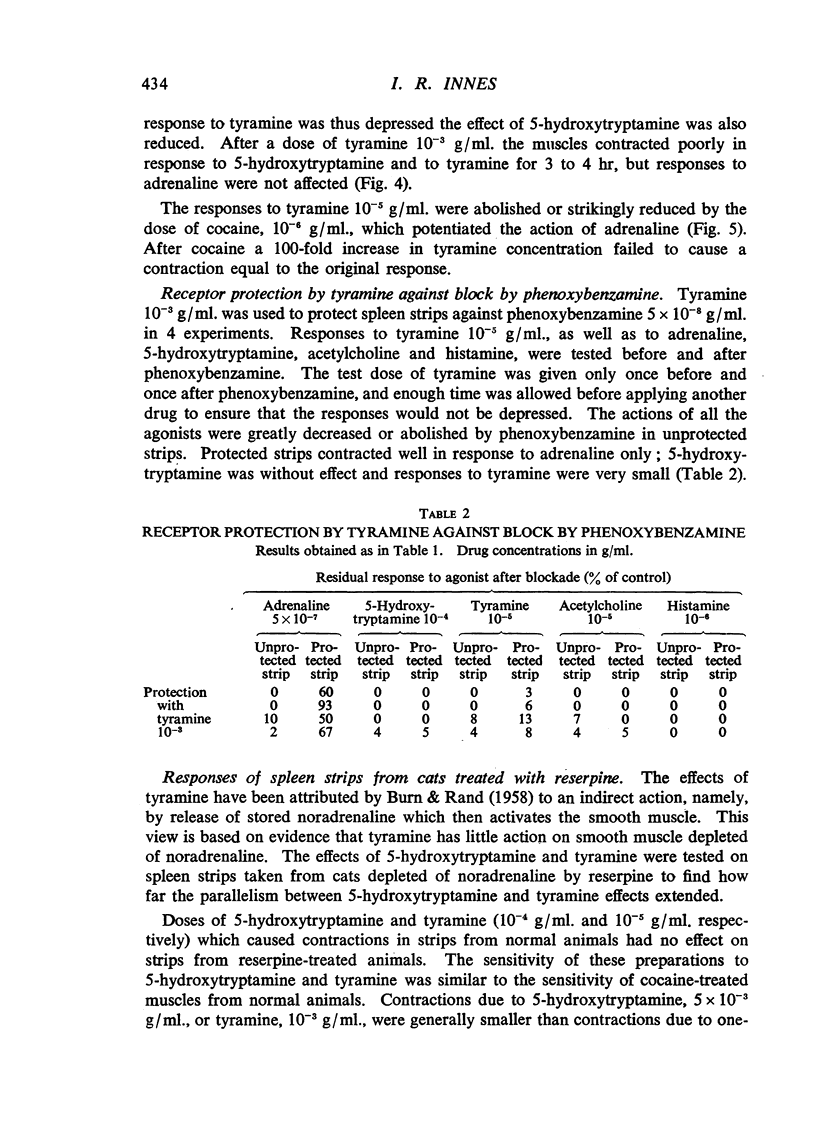Abstract
Contractions of isolated strips of cat spleen due to 5-hydroxytryptamine, adrenaline, histamine and acetylcholine were antagonized by phenoxybenzamine. Responses to both 5-hydroxytryptamine and adrenaline were not blocked in strips which were protected by a high concentration of either 5-hydroxytryptamine or adrenaline throughout exposure to phenoxybenzamine. The contraction due to a large dose of 5-hydroxytryptamine lasted less than 1 hr even when the drug was still present. Strips thus desensitized to 5-hydroxytryptamine responded normally to acetylcholine and histamine but did not respond to adrenaline. The actions of 5-hydroxytryptamine and adrenaline were blocked by 2-bromolysergic acid diethylamide or by dihydroergotamine. These results indicated that 5-hydroxytryptamine and adrenaline act on the same receptors. Cocaine potentiated the action of adrenaline but inhibited the action of 5-hydroxytryptamine. The sensitivity to 5-hydroxytryptamine of spleen strips from cats treated 24 hr earlier with reserpine was only one-fiftieth of that of normal strips. Cocaine potentiated the action of 5-hydroxytryptamine on strips from reserpine-treated cats. A high concentration of 5-hydroxytryptamine in spleen strips from reserpine-treated cats and in cocaine-treated strips prevented phenoxybenzamine from blocking the actions of adrenaline. The effects of tyramine on spleen strips almost exactly paralleled the effects of 5-hydroxytryptamine. Strips showing tachyphylaxis to tyramine did not respond to 5-hydroxytryptamine. It is concluded that 5-hydroxytryptamine has a dual action, viz., a major action due to release of stored noradrenaline and a minor direct action of adrenaline receptors.
Full text
PDF














Selected References
These references are in PubMed. This may not be the complete list of references from this article.
- BURN J. H., RAND M. J. The action of sympathomimetic amines in animals treated with reserpine. J Physiol. 1958 Dec 4;144(2):314–336. doi: 10.1113/jphysiol.1958.sp006104. [DOI] [PMC free article] [PubMed] [Google Scholar]
- ERSPAMER V. Pharmacological studies on enteramine (5-hydroxytryptamine) IX. Influence of sympathomimetic and sympatholytic drugs on the physiological and pharmacological actions of enteramine. Arch Int Pharmacodyn Ther. 1953 Apr;93(3-4):293–316. [PubMed] [Google Scholar]
- FURCHGOTT R. F. Dibenamine blockade in strips of rabbit aorta and its use in differentiating receptors. J Pharmacol Exp Ther. 1954 Jul;111(3):265–284. [PubMed] [Google Scholar]
- GADDUM J. H., HAMEED K. A. Drugs which antagonize 5-hydroxytryptamine. Br J Pharmacol Chemother. 1954 Jun;9(2):240–248. doi: 10.1111/j.1476-5381.1954.tb00848.x. [DOI] [PMC free article] [PubMed] [Google Scholar]
- GADDUM J. H., HAMEED K. A., HATHWAY D. E., STEPHENS F. F. Quantitative studies of antagonists for 5-hydroxytryptamine. Q J Exp Physiol Cogn Med Sci. 1955 Jan;40(1):49–74. doi: 10.1113/expphysiol.1955.sp001097. [DOI] [PubMed] [Google Scholar]
- GADDUM J. H., PICARELLI Z. P. Two kinds of tryptamine receptor. Br J Pharmacol Chemother. 1957 Sep;12(3):323–328. doi: 10.1111/j.1476-5381.1957.tb00142.x. [DOI] [PMC free article] [PubMed] [Google Scholar]
- GADDUM J. H. Tryptamine receptors. J Physiol. 1953 Feb 27;119(2-3):363–368. doi: 10.1113/jphysiol.1953.sp004851. [DOI] [PMC free article] [PubMed] [Google Scholar]
- GINZEL K. H., KOTTEGODA S. R. A study of the vascular actions of 5-hydroxytryptamine, tryptamine, adrenaline and noradrenaline. Q J Exp Physiol Cogn Med Sci. 1953;38(4):225–231. doi: 10.1113/expphysiol.1953.sp001033. [DOI] [PubMed] [Google Scholar]
- HERTTING G., AXELROD J., PATRICK R. W. Actions of cocaine and tyramine on the uptake and release of H3-norepinephrine in the heart. Biochem Pharmacol. 1961 Sep;8:246–248. doi: 10.1016/0006-2952(61)90009-0. [DOI] [PubMed] [Google Scholar]
- LOCKETT M. F., EAKINS K. E. Chromatographic studies of the effect of intravenous injections of tyramine on the concentrations of adrenaline and noradrenaline in plasma. J Pharm Pharmacol. 1960 Sep;12:513–517. doi: 10.1111/j.2042-7158.1960.tb12702.x. [DOI] [PubMed] [Google Scholar]
- MEIER R., TRIPOD J., WIRZ E. Classification d'une série d'antagonistes de la sérotonine et analyse de ses points d'attaque vasculaires périphériques. Arch Int Pharmacodyn Ther. 1957 Jan 1;109(1-2):55–77. [PubMed] [Google Scholar]
- MUSCHOLL E. Effect of cocaine and related drugs on the uptake of noradrenaline by heart and spleen. Br J Pharmacol Chemother. 1961 Jun;16:352–359. doi: 10.1111/j.1476-5381.1961.tb01095.x. [DOI] [PMC free article] [PubMed] [Google Scholar]
- WHITBY L. G., HERTTING G., AXELROD J. Effect of cocaine on the disposition of noradrenaline labelled with tritium. Nature. 1960 Aug 13;187:604–605. doi: 10.1038/187604a0. [DOI] [PubMed] [Google Scholar]


